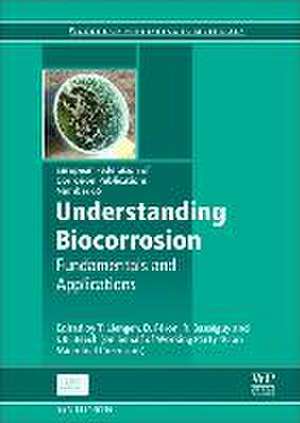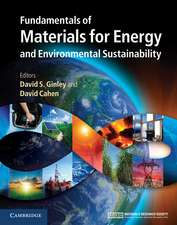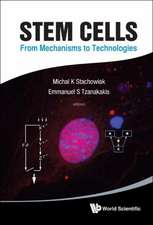Understanding Biocorrosion: Fundamentals and Applications: European Federation of Corrosion (EFC) Series, cartea 66
Autor T Liengen, R Basseguy, Damien Feron, I Beechen Limba Engleză Hardback – 5 noi 2014
- Provides a detailed overview of biocorrosion and the different scientific and/or industrial problems related to microbially induced corrosion
- Introduces a variety of investigative techniques and methodologies that are employed in diagnosing and evaluating microbially induced corrosion
- Includes case studies on: biodeterioration of building materials; biocorrosion issues associated with diesel and biofuels; marine biocorrosion; corrosion of open recirculating cooling water systems and cooling system components; the effect of H2S on steel corrosion
Preț: 1070.24 lei
Preț vechi: 1401.35 lei
-24% Nou
Puncte Express: 1605
Preț estimativ în valută:
204.79€ • 214.26$ • 170.12£
204.79€ • 214.26$ • 170.12£
Carte tipărită la comandă
Livrare economică 26 martie-09 aprilie
Preluare comenzi: 021 569.72.76
Specificații
ISBN-13: 9781782421207
ISBN-10: 1782421203
Pagini: 446
Dimensiuni: 152 x 229 x 32 mm
Greutate: 0.79 kg
Editura: ELSEVIER SCIENCE
Seria European Federation of Corrosion (EFC) Series
ISBN-10: 1782421203
Pagini: 446
Dimensiuni: 152 x 229 x 32 mm
Greutate: 0.79 kg
Editura: ELSEVIER SCIENCE
Seria European Federation of Corrosion (EFC) Series
Cuprins
- List of contributors
- Series introduction
- Volumes in the EFC series
- Preface
- Part One: Turbomachinery Development
- 1: Understanding corrosion: basic principles
- 1.1 Introduction
- 1.2 Materials and surfaces
- 1.3 Basic corrosion processes
- 1.4 Main forms of corrosion degradation
- 1.5 Conclusion
- 2: Biofilms and biocorrosion
- 2.1 Introduction
- 2.2 Biofilms
- 2.3 Corrosion and biocorrosion
- 2.4 Molecular techniques for the investigation of biofilm communities
- 2.5 DNA microarrays
- 2.6 Mass spectrometric metabolomics for the study of biofilm-influenced corrosion
- 2.7 Conclusions
- Acknowledgements
- 3: Molecular methods for studying biocorrosion
- 3.1 Introduction
- 3.2 Requirements for molecular biological studies
- 3.3 Molecular methods based on the analysis of the 16S- and 18S-rRNA gene sequences
- 3.4 Functional genes as a molecular tool
- 3.5 Other useful methods
- 4: Sulphate-reducing bacteria (SRB) and biocorrosion
- 4.1 Introduction
- 4.2 Microbially induced corrosion (MIC)
- 4.3 Sulphate-reducing bacteria (SRB): bringing together hydrogen, sulphur and nitrogen biocycles
- 4.4 Electron transfer (ET) processes relevant for SRB
- 4.5 Bacteria and metal surfaces: influence of extracellular polymeric substances (EPSs)
- 4.6 Useful methods and tools for MIC assessment
- 4.7 Conclusions
- Acknowledgements
- 5: Electroactive biofilms
- 5.1 Introduction
- 5.2 Different types of electron transfer mechanisms
- 5.3 Examples of electroactive biofilms (EABs) from the lab
- 5.4 EABs and technological applications
- 5.5 EABs and biocorrosion
- 5.6 Conclusions
- 6: Immobilization and trapping of living bacteria and applications in corrosion studies
- 6.1 Introduction
- 6.2 Materials and methods
- 6.3 Immunoimmobilization, trapping bacteria and applications
- 6.4 BiyoTrap and applications
- 6.5 Conclusions
- Acknowledgements
- 1: Understanding corrosion: basic principles
- Part Two: Evaluating and modelling biocorrosion
- 7: Physical and local electrochemical techniques for measuring corrosion rates of metals
- 7.1 Introduction
- 7.2 Global measurement of corrosion rate
- 7.3 Electrochemical techniques for monitoring generalized corrosion
- 7.4 Electrochemical techniques for monitoring localized corrosion
- 7.5 Conclusions
- 8: Surface analysis techniques for investigating biocorrosion
- 8.1 Introduction
- 8.2 X-ray photoelectron spectroscopy (XPS) analysis
- 8.3 Time-of-flight secondary ion mass spectrometry (ToF-SIMS) analysis
- 8.4 Combining different analysis techniques
- 8.5 Conclusions
- 9: Modelling long term corrosion of steel infrastructure in natural marine environments
- 9.1 Introduction
- 9.2 Models and modelling
- 9.3 Models for corrosion
- 9.4 Factors involved in marine corrosion
- 9.5 Microbiologically influenced corrosion (MIC)
- 9.6 Corrosion loss model
- 9.7 Effects of nutrient pollution
- 9.8 Accelerated low water corrosion (ALWC)
- 9.9 Evaluating the effect of nutrient pollution
- 9.10 Conclusions
- Acknowledgements
- 10: Modeling mechanisms in biocorrosion
- 10.1 Introduction
- 10.2 Corrosion diagrams
- 10.3 Interfacial changes due to microbially influenced corrosion (MIC)
- 10.4 Localized corrosion
- 10.5 Modeling
- 10.6 Conclusions and recommendations
- 7: Physical and local electrochemical techniques for measuring corrosion rates of metals
- Part Three: Case studies
- 11: Biodeterioration of concrete, brick and other mineral-based building materials
- 11.1 Introduction
- 11.2 Biodeterioration of natural and man-made building materials
- 11.3 Microorganisms that cause the biodeterioration of mineral-based materials
- 11.4 Factors contributing to the biodeterioration of mineral-based materials
- 11.5 Symptoms of mineral-based material biodeterioration
- 11.6 The case of concrete biodeterioration
- 11.7 The case of bricks and mortar biodeterioration
- 11.8 Conclusions
- 12: Biocorrosion issues associated with the use of ultra-low sulfur diesel and biofuel blends in the energy infrastructure
- 12.1 Introduction
- 12.2 The need for cleaner diesel fuel
- 12.3 The impact of organosulfur compounds on anaerobic metabolism
- 12.4 The impact of desulfurization on diesel fuel stability
- 12.5 Assessment of diesel additives: fatty acid methyl esters (FAME)
- 12.6 Fuel composition and inocula are equally important
- 12.7 Conclusions
- 13: Understanding marine biocorrosion: experiments with artificial and natural seawater
- 13.1 Introduction
- 13.2 Effect of nutrients and oxygen removal on biocorrosion
- 13.3 Comparison of experiments in natural and artificial seawater
- 13.4 Variability in the composition of natural seawater
- 13.5 Conclusions
- Acknowledgements
- 14: Managing open recirculating cooling water systems to minimize contamination and corrosion
- 14.1 Introduction
- 14.2 Description of the scope of the work
- 14.3 Conclusions
- 14.4 Sources of further information and advice
- Acknowledgements
- Appendix 1 Scope of the work document for open recirculating cooling water systems, 1/31/2013, Company X, Plant X, supplier service requirements
- Appendix 2 Guidelines for best practices for the control of Legionella, July 2008
- 15: Risk assessment of biocorrosion in condensers, pipework and other cooling system components
- 15.1 Introduction
- 15.2 Biofouling/biocorrosion
- 15.3 Biocorrosion risk mitigation
- 15.4 Monitoring systems
- 15.5 Conclusions
- 16: The effect of H2S on the corrosion of steels
- 16.1 Introduction
- 16.2 Carbon steel and low alloy steels in H2S containing solutions
- 16.3 Stainless steels: microstructures and corrosion
- 16.4 Conclusion
- 11: Biodeterioration of concrete, brick and other mineral-based building materials
- Index





















